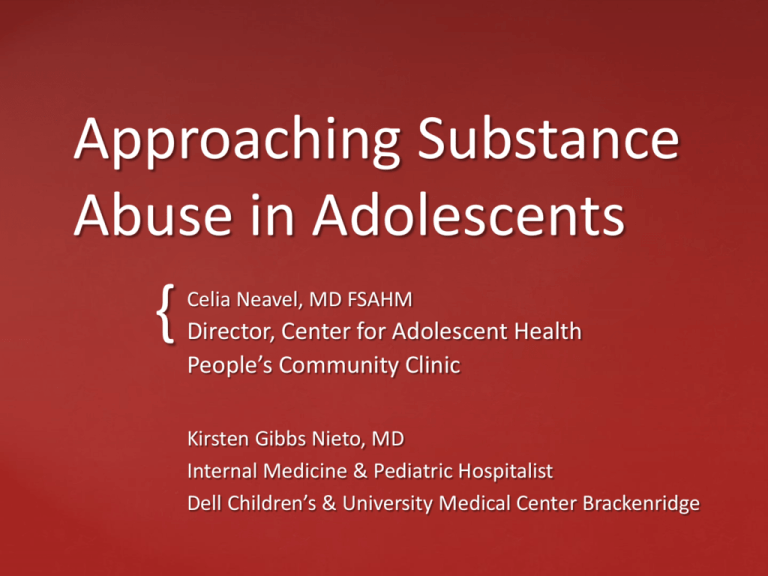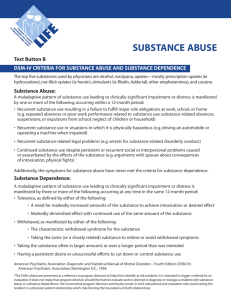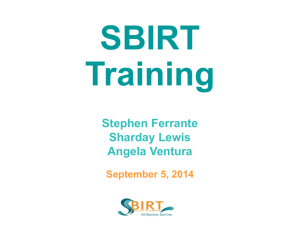Approaching Substance Abuse in Adolescents
advertisement

Approaching Substance
Abuse in Adolescents
{
Celia Neavel, MD FSAHM
Director, Center for Adolescent Health
People’s Community Clinic
Kirsten Gibbs Nieto, MD
Internal Medicine & Pediatric Hospitalist
Dell Children’s & University Medical Center Brackenridge
Case Presentation
National & Local Statistics
Screening (Procedure applied to populations & intended
to identify those w/ disease, condition, or symptom. Does not yield
diagnosis, but guides further decision-making)
Intervening (Screening outcome-responsive
conversation that focuses on encouraging making healthy choices &
personal behavior changes regarding risky activity)
Resources
OUTLINE
17 year old male in your office for WCC
Sister is seeing your partner and in therapy
Mother is upset and wants to speak with
you alone
JULIO
Smoking marijuana daily
Does not think this is a problem
Attending school, has a counselor he
likes, wants to be a chef
Has a girlfriend who stays sober
Family chaos
JULIO
Monitoring the Future (MTF)
Survey 2013
11.4% in 2011
(K2/Spice)
10.5% in 2005
6.9% in 2006
15%
Bath Salts
0.9%
Alcohol use among
teens remains at
historically low
levels
{
NIDA Monitoring the Future Survey
2013
{
Now Fewer Teens Smoke Cigarettes than Marijuana
2008
2013
8th
5.8%
7%
10th
13.8% 18%
12th
19.4% 22.7%
AISD Student Substance
Abuse & Safety Survey 2013
You can find data on the
specific schools in your area…
AISD Survey 2013
AISD High School Students
Self Reporting Marijuana Use
2012-13
AISD Middle School Students
Self Reporting Marijuana Use
2012-13
“I’ve Never Heard of that Drug!”
NIDA EMERGING TRENDS
Update Local Drugs of
Abuse
{ Contributed by John Abraham DO,
Child and Adolescent Psychiatrist
Collaboracare and Phoenix Academy
Packaged under a variety of names
Not easily detected under basic drug screens
Not one single compound but an ever changing array of
synthetic cannabis
Intoxication is similar to cannabis
However, more profound effects are seen
Paranoia
Alterations in sense of time
Migraines
In one instance, I had a patient develop “Alice in Wonderland
Syndrome” extending weeks after last use
New Synthetics “K2” “spice”
A cheap, easy way to get high
At high levels can cause hallucination, dissociation,
rapid heart rate
If used in a form with acetomeniphen can cause
liver damage
Often used in combination with other drugs
DXM can increase the effective concentration of
other serotoninergic drugs (fluoxetine and others)
and increase the risk of serotonin syndrome
Dextromethorphan “DXM”
Effects are increase alertness, irritability, or euphoria
ADHD meds
Dextroamphetamine and more short acting formulations seem to be
more easily abused (but all of them can be!)
Keep in mind that both clonidine and guanfacine are also used in
ADHD treatment. A patient abusing a peers “ADHD meds” may not
know the difference
Usually taken orally when abused
Stimulants
Does not appear to be a major local contributor
However, they are packaged and distributed in the same way that
K2/spice is so a person may not know what they have
Just like synthetics the compound is ever changing
Seems to be most closely associated with Mephadrone which is
similar to effects of MDMA, cocaine, amphetamines
Bath Salts
Starting to make a comeback
Often starts with Rx opiate abuse that becomes too
expensive
Hydrocodone pills cost $5 to $15 on the street
Heroin
Hydrocodone/opiate derivatives
Often in forms with Acetaminophen (liver damage)
Can be a number of different drugs from tramadol to
antihypertensive meds
Inquire about a child or teenagers access to drugs at
relatives and friends homes
Prescription Abuse
“Duster” air can computer duster = easy and cheap
way to get high
Inhalants
Assess What
How
Substance Abuse Severity +
Home Life
Psychiatric Status
School Status
Short Questionnaire
Brief Interview
Whom
Youth
Accompanying Adult
http://store.samhsa.gov/shin/content//SMA12-3597/SMA123597.pdf
SCREENING
CRAFFT
“I’m going to ask you a few questions that I ask all my patients.
Please be honest. I will keep your answers confidential.”
Part A: During the PAST 12 MONTHS, did you:
1. Drink any alcohol (more than a few sips)?
(Do not count sips of alcohol taken during family or religious events.
2. Smoke any marijuana or hashish?
3. Use anything else* to get high?
*includes illegal drugs, over-the-counter,
prescription drugs, and things that you sniff
http://www.ceasar-boston.org/clinicians/crafft.php
1. Have you ever ridden in a CAR
driven by someone (including yourself) who was
“high” or had been using alcohol or drugs?
2. Do you ever use alcohol or drugs to RELAX, feel better about yourself, or fit in?
3. Do you ever use alcohol or drugs while you are by yourself, or ALONE?
4. Do you ever FORGET things you did while using alcohol or drugs?
5. Do your FAMILY or FRIENDS ever tell you that you should cut down on
your drinking or drug use?
6. Have you ever gotten into TROUBLE while you were using alcohol or drugs?
CRAFFT-Part B
Each “yes” response in Part B scores 1 point.
≥2 is (+), need for additional assessment
Probability of substance abuse/dependence
diagnosis correlates with # of (+) answers
CRAFFT Scoring
Abuse = 1 or more:
Use causes failure to fulfill
obligations work, home, school
Recurrent Use in Hazardous Settings
Recurrent Legal Problems
Continued Use Despite Recurrent
Problems
ABUSE vs DEPENDENCE
Dependence = 3 or more:
Tolerance
Withdrawal
Use larger amounts or over longer time than planned
Unsuccessful efforts to cut down or quit
Great deal of time spent obtaining or recovering from
Important activities given up because of
Continued use despite harmful consequences
ABUSE vs DEPENDENCE
DRUG
DURATION OF DETECTABILITY
Alcohol
Very Short
Amphetamine
2-4 Days
Methamphetamine
2-4 Days
Barbiturates (most types)
2-4 Days
Phenobarbital
Up to 30 Days
Benzodiazepines
Up to 30 Days
Cocaine
12-72 Hours
Methadone
2-4 Days
Opioids (heroin, codeine)
2-4 Days
Marijuana casual
2-7 Days
Marijuana chronic
Up to 30 Days
Phencylidene casual
2-7 Days
PCP chronic
Up to 30 Days
DRUG SCREENING?
http://store.samhsa.gov/shin/content//SMA12-3597/SMA12-3597.pdf
Home Life
Delinquency History
Physical/Sexual Abuse
History
Medical Status
Learning Status
In-Depth Psychiatric Status
Environmental Risks
Environmental
Assets/Strengths
Sexual Behavior
Developmental
Status
Leisure &
Recreational
Preferences
Family Dynamics
COMPREHENSIVE ASSESSMENT
Screening, Brief Intervention, and Referral to
Treatment
Endorsed by SAHMSA and AAP
Use Motivational Interviewing Skills
http://pediatrics.aappublications.org/content/e
arly/2011/10/26/peds.2011-1754.full.pdf+html
SBIRT
Stage
Description
Office Intervention
Goals
Abstinence (CRAFFT -,
Low Risk)
Time before ever used
drugs or alcohol
(more than a few sips)
Prevent/delay initiation
through positive
reinforcement &
patient/parent education
Experimentation (CRAFFT The first 1–2 x use &
Promote strengths;
0-1, Mod Risk)
wants to know how using encourage abstinence &
feels
cessation through brief,
clear medical advice &
educational counseling
Limited Use (CRAFFT 0-1, W/friends in relatively
Mod Risk)
low-risk situations
& without problems;
typically occurs
predictable times,
weekends
Promote strengths;
encourage cessation
through brief, clear
medical advice &
educational counseling
Substance Use Spectrum and Goals for Office
Intervention
Stage
Description
Office Intervention Goals
Problematic Use (CRAFFT 2+,
High Risk)
Use in high-risk situation, i.e.
driving/babysitting; use associated
w/problem like fight, arrest, school
suspension; use for emotional
regulation to relieve stress or
depression
Above + initiate office visits or
referral for brief intervention to
enhance motivation to make
behavioral changes; provide
close follow-up; consider
breaking confidentiality
Abuse (CRAFFT +, High Risk)
Associated w/ recurrent problems
or interferes w/ functioning as
defined in the DSM-IV
Above + enhance motivation to
make behavioral changes,
explore ambivalence & triggering
preparation for action; monitor
closely for progression to
addiction; refer for
comprehensive assessment &
treatment; consider breaking
confidentiality
Addiction/Dependence
(CRAFFT +, High Risk)
Loss of control or compulsive drug
use, as defined in the DSM-IV-TR
as “dependence”
Above, + enhance motivation to
accept referral to subspecialty
treatment if necessary; consider
breaking confidentiality;
encourage parental involvement
whenever possible
Summarize Assessment
Repeat for Emphasis Problems
Experienced
Ask if would Like to Change
Consider Signed Contract
Risk/Harm Reduction
Follow-up
BRIEF NEGOTIATING INTERVIEW
I _________________ agree to not drink alcohol, use
drugs, or take anyone else’s medication for the next _____
days. I also will not provide drugs, alcohol, or prescription
medications for anyone else during this time. In addition, I
agree to not drive a motor vehicle while under the
influence of drugs or alcohol, nor will I ride with a driver
who has been drinking or using drugs. I will come to my
follow-up appointment with ______________on
___________.
Signed, ________________________
Date: ____________________
SIGNED CONTRACT
http://www.youtube.com/w
atch?v=fX90j4jD9Sc
http://withcarson.org/
http://awareawakealive.org
https://awareawakealive.org/
educate/911-lifelinelegislation
CARSON
Local Examples
Austin Travis County Integral Care (ATCIC)
Free evening groups 512-804-3101,
CFSInfro@atcic.org,
http://atcic.org/content/adolescent-substanceuse
-Phoenix Academy www.phoenixhouse.org
Inpatient
Shoal Creek http://www.seton.net/locations/shoal_creek/
Austin Oaks http://austinoakshospital.com/
Children’s Optimal Health www.childrensoptimalhealth.org
Private therapists, psychiatrists
Others
http://www.cleaninvestmentsinc.com
http://parc.memorialhermann.org/locations/austin-outpatient-rehab/
http://starlite.crchealth.com/
http://www.summersky.us/
RESOURCES
Online
http://familymed.uthscsa.edu/sstart/resourcesOPEN.asp
Substance Use Screening, Brief Intervention, and Referral to Treatment
for Pediatricians COMMITTEE ON SUBSTANCE ABUSED Pediatrics
originally published online October 31, 2011; DOI: 10.1542/peds.20111754
Quick Guide for Physicians
http://store.samhsa.gov/shin/content//SMA12-3597/SMA12-3597.pdf
Substance Abuse and Mental Health
Services Administration http://www.samhsa.gov/
RESOURCES
17 YO in your office for WCC
Sister seeing your partner and in therapy
Mom upset, wanting to speak with you alone
Smoking MJ daily
Doesn’t think is problem
Attending school, has counselor likes, wants to be
a chef
Has girlfriend who stays sober
Family chaos
JULIO




